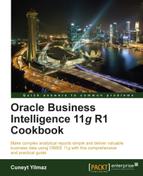Book Description
Here’s an opportunity to learn all the key elements of the OBIEE 11g suite by doing tasks rather than just reading. Packed with practical recipes, it empowers you to create complex analytical reports with minimum effort.
- Improve the productivity of business intelligence solution to satisfy business requirements with real-life scenarios
- Practical guide on the implementation of OBIEE 11g from A to Z including best practices
- Full of useful instructions that can be easily adapted to build better business intelligence solutions
In Detail
Extracting meaningful and valuable business information from transactional databases is crucial for any organization. OBIEE 11g is a reporting tool that satisfies all the business requirements regarding complex reporting. It consists of a powerful back-end engine with a repository and a highly customizable graphical web interface.
Oracle Business Intelligence 11g R1 Cookbook provides all the key concepts of the product including the architecture of the BI Server. This practical guide shows each and every step of creating analytical reports starting from building a well-designed repository. You will learn how to create analytical reports that will support different business perspectives.
This practical guide covers how to implement OBIEE 11g suite in order to enable BI developers to create sophisticated web based reports. All of tasks will be covered step by step in detail.
You will explore the architecture of the Oracle Business Intelligence Server and learn how to build the repository (RPD). We will also discuss how to implement the business rules in the repository with real-life scenarios.
Best practices of a successful BI implementation are esssential for any BI developer so they are also covered in depth.If you are planning to implement OBIEE 11g suite, this step-by-step guide is a must have resource.All the key tasks are defined in detail and supported with diagrams and screenshots.
Table of Contents
- Oracle Business Intelligence 11g R1 Cookbook
- Table of Contents
- Oracle Business Intelligence 11g R1 Cookbook
- Credits
- About the Author
- About the Reviewers
- www.PacktPub.com
- Preface
- 1. Exploring and Building the Repository
- Introduction
- Building the Physical layer in the repository
- Building the Business Model and Mapping layer
- Adding multiple sources to the logical table source
- Adding calculations to the fact table
- Creating variables
- Building the Presentation layer
- Validating the repository using Consistency Check Manager
- Uploading the repository
- 2. Working with Logical Dimensions
- 3. Using Aggregates and the Time Series Functions
- 4. Working with Multidimensional Data Sources
- 5. Security in Oracle BI
- 6. Managing Usage Tracking and Enabling the Cache
- 7. Creating Simple Oracle Business Intelligence Analyses
- 8. Adding Views to Analyses and Advanced Features
- 9. Measuring Performance with Key Performance Indicators
- 10. Creating and Configuring Dashboards
- 11. Oracle BI Best Practices
- A. The Major Components of OBIEE 11g
- Index
